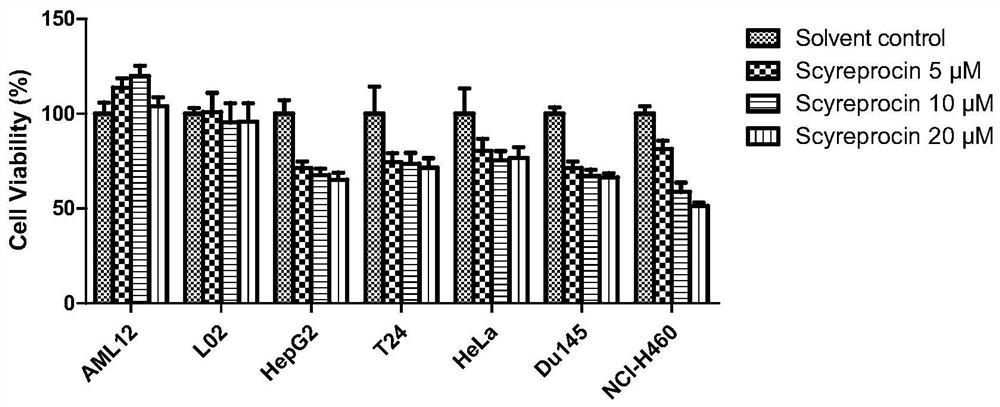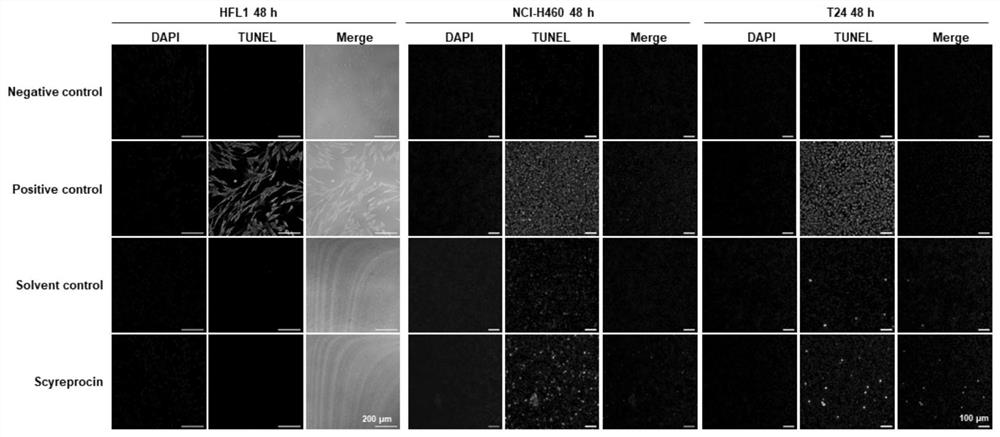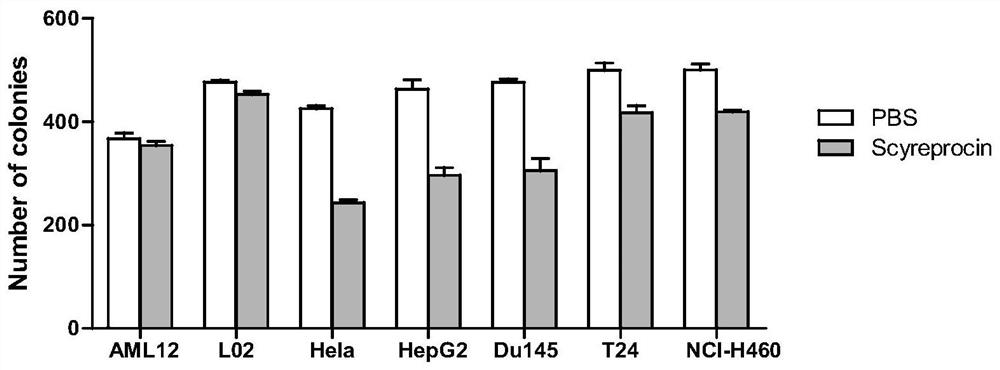New function and use of cryptoid crab antimicrobial peptide scyreprocin
A technology of Scyreprocin and antimicrobial peptides, which can be applied in the direction of antibacterial drugs, antifungal agents, peptides, etc., can solve the problem that there is no Scyreprocin on cancer cells, and achieve good biological friendliness
- Summary
- Abstract
- Description
- Claims
- Application Information
AI Technical Summary
Problems solved by technology
Method used
Image
Examples
Embodiment 1
[0037] Example 1 Determination of the concentration of antimicrobial peptide Scyreprocin inhibiting the growth of cancer cells
[0038] In this part, human cervical cancer cells (HeLa), human transitional bladder cancer cells (T24), mouse liver cells (AML12), human liver cells (L02), human non-small cell lung cancer cells (NCl-H460), human Bladder cancer cells (Du145) and human liver cancer cells (HepG2) were used as the test cells, and the activity of antimicrobial peptide Scyreprocin to inhibit cell proliferation was measured.
[0039] (a) After the cells are cultured in the corresponding cell culture medium until the cell conjugation degree is 80-90%, they are digested with EDTA-containing trypsin and resuspended with the corresponding cell culture medium, and the cell density is adjusted with the corresponding cell culture medium. Seed the cells in the culture plate and place in a cell culture incubator at 37°C in 5% CO 2 overnight culture under conditions.
[0040] (b) ...
Embodiment 2
[0043] Example 2 Detection of the apoptosis of cancer cells induced by the antimicrobial peptide Scyreprocin
[0044] In this part, human non-small cell lung cancer cells (NCl-H460), human transitional bladder cancer cells (T24), and human lung fibroblasts (HFL1) were selected as the test cells, and the antimicrobial peptide Scyreprocin induced cancer cell apoptosis. death detection.
[0045] (a) After the cells were cultured in the corresponding cell culture medium until the cell conjugation degree was 80-90%, they were digested with EDTA-containing trypsin and resuspended with the corresponding cell culture medium, and the cell density was adjusted with the corresponding cell culture medium. Seed the cells in the culture plate and place in a cell culture incubator at 37°C in 5% CO 2 overnight culture under conditions.
[0046](b) When the cells in each well grow to about 70-80% conjugation, suck off the cell culture medium, and dilute the Scyreprocin protein to 1, 5, 10, a...
Embodiment 3
[0052] Example 3 Determination of the Antimicrobial Peptide Scyreprocin Inhibiting the Growth of Cancer Cell Clones
[0053] In this part, human cervical cancer cells (HeLa), human transitional bladder cancer cells (T24), mouse liver cells (AML12), human liver cells (LO2), human non-small cell lung cancer cells (NCl-H460), human Bladder cancer cells (Du145) and human liver cancer cells (HepG2) were used as test cells to evaluate the effect of Scyreprocin on the ability of different cells to form clones.
[0054] (a) After the cells were cultured in the corresponding cell culture medium until the cell conjugation degree was 80-90%, they were digested with EDTA-containing trypsin and resuspended with the corresponding cell culture medium, and the cell density was adjusted with the corresponding cell culture medium. Inoculate 500 cells per well in the culture plate and place in a cell culture incubator at 37°C in 5% CO 2 Under the conditions, culture overnight until the cells ad...
PUM
| Property | Measurement | Unit |
|---|---|---|
| molecular weight | aaaaa | aaaaa |
Abstract
Description
Claims
Application Information
 Login to View More
Login to View More - R&D
- Intellectual Property
- Life Sciences
- Materials
- Tech Scout
- Unparalleled Data Quality
- Higher Quality Content
- 60% Fewer Hallucinations
Browse by: Latest US Patents, China's latest patents, Technical Efficacy Thesaurus, Application Domain, Technology Topic, Popular Technical Reports.
© 2025 PatSnap. All rights reserved.Legal|Privacy policy|Modern Slavery Act Transparency Statement|Sitemap|About US| Contact US: help@patsnap.com



